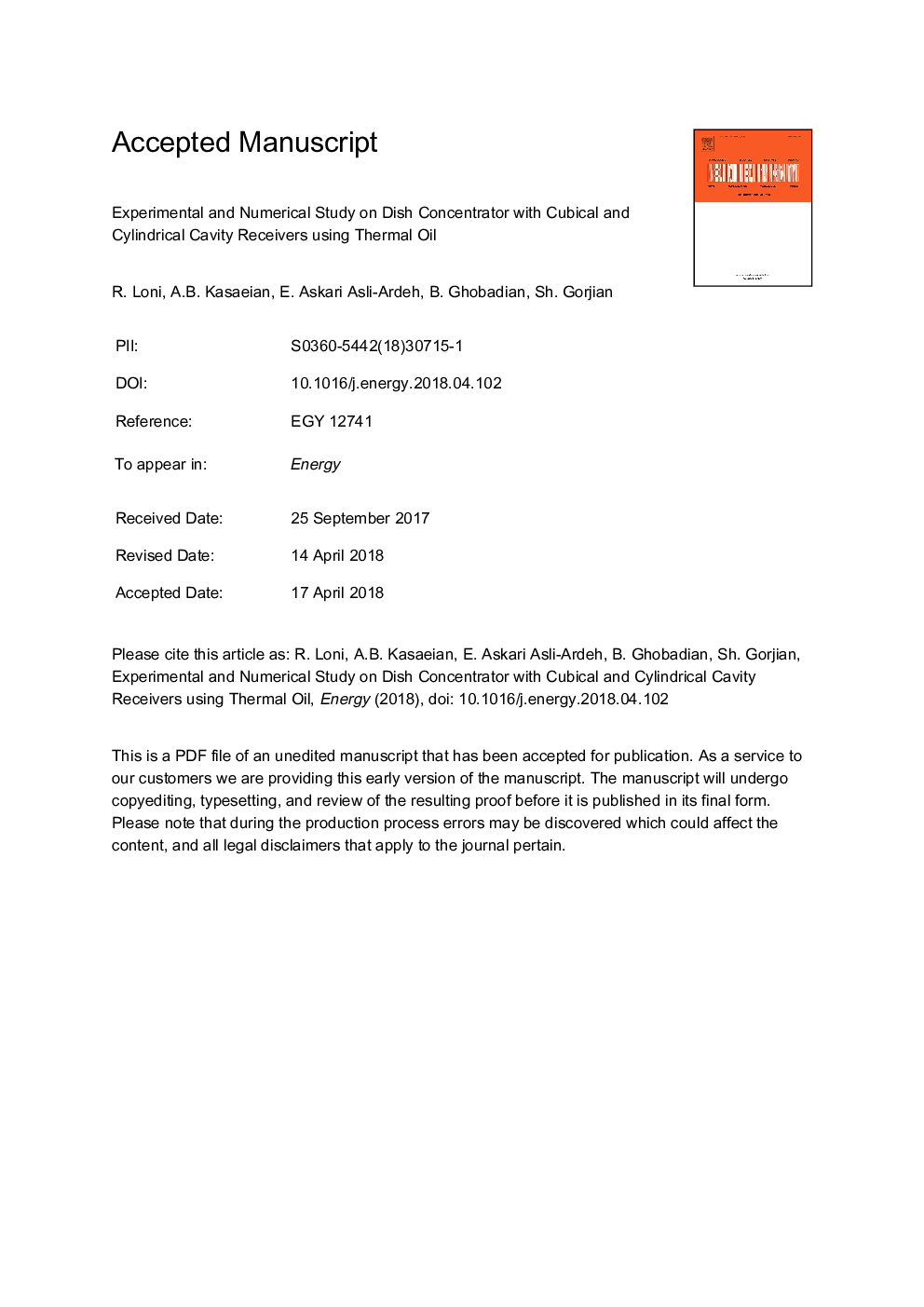| کد مقاله | کد نشریه | سال انتشار | مقاله انگلیسی | نسخه تمام متن |
|---|---|---|---|---|
| 8071431 | 1521396 | 2018 | 37 صفحه PDF | دانلود رایگان |
عنوان انگلیسی مقاله ISI
Experimental and numerical study on dish concentrator with cubical and cylindrical cavity receivers using thermal oil
ترجمه فارسی عنوان
بررسی تجربی و عددی بر روی کنتراتور ظرف با گیرنده های حفره ای مکعبی و استوانه ای با استفاده از روغن حرارتی
دانلود مقاله + سفارش ترجمه
دانلود مقاله ISI انگلیسی
رایگان برای ایرانیان
کلمات کلیدی
تجزیه و تحلیل تجربی، گیرنده های حفره مکعبی و استوانه ای، تجزیه و تحلیل انرژی، نفت حرارتی، دیگ بخار خورشیدی،
ترجمه چکیده
در این مطالعه، یک غلاف پارابولیک با دو نوع گیرنده حفره مورد بررسی قرار گرفت. مجموعه آزمایش تجربی طراحی شامل یک غلاف پارابولیک، گیرنده حفره، یک سیستم مبدل حرارتی و واحد مدار هیدرولیکی بود. دو اشکال بهینه شده گیرنده حفره مکعبی و استوانه ای ساخته و مورد مطالعه قرار گرفتند. همچنین مدلسازی عددی برای پیش بینی عملکرد گیرنده حفره ایجاد شده است. نتایج عددی گیرنده های حفره نشان می دهد که توافق خوبی با نتایج تجربی است. نتایج نشان می دهد که افزایش گرما گیرنده و بازده حرارتی گیرنده های حفره روند مشابهی را نسبت به اختلاف دما در انتقال مایعات گرما بین ورودی و خروجی گیرنده های حفره داشته اند. نتایج همچنین بیان داشت که بازده حرارتی گیرنده حفره مکعبی بالاتر از بازده حرارتی گیرنده حفره استوانه ای در دوره حالت پایدار است. متوسط بازده حرارتی گیرنده دیافراگم مکعبی و استوانه ای به ترتیب به ترتیب 65.14٪ و 44.46٪ در حالت پایدار بدست آمد. گیرنده حفره مکعبی را می توان برای افزایش گرما کارآمد، در مقایسه با گیرنده حفره استوانه ای بر اساس آزمایش های انجام شده در 11 اکتبر و 26 سپتامبر 2016 توصیه می شود.
موضوعات مرتبط
مهندسی و علوم پایه
مهندسی انرژی
انرژی (عمومی)
چکیده انگلیسی
In this study, a parabolic dish concentrator with two types of cavity receivers was investigated. The designed experimental setup included a parabolic dish concentrator, cavity receivers, a heat exchanger system, and hydraulic circuit unit. Two optimized shapes of cubical and cylindrical cavity receiver were made and studied. Also, numerical modeling was developed for predicting the cavity receiver performance. The numerical results of the cavity receivers show a good agreement with the experimental results. The results indicated that the receiver heat gain and thermal efficiency of the cavity receivers had a similar trend compared to the temperature difference of the heat transfer fluid between the inlet and outlet of the cavity receivers. The results also clarified that the thermal efficiency of the cubical cavity receiver was higher than the thermal efficiency of the cylindrical cavity receiver in the steady-state period. The average thermal efficiency of the cubical and cylindrical cavity receiver was obtained as 65.14% and 56.44% in the steady-state period, respectively. The cubical cavity receiver can be recommended for an efficient heat gain, in comparison with the cylindrical cavity receiver based on the conducted experimental tests on 11 October, and 26 September 2016.
ناشر
Database: Elsevier - ScienceDirect (ساینس دایرکت)
Journal: Energy - Volume 154, 1 July 2018, Pages 168-181
Journal: Energy - Volume 154, 1 July 2018, Pages 168-181
نویسندگان
R. Loni, A.B. Kasaeian, E. Askari Asli-Ardeh, B. Ghobadian, Sh Gorjian,
